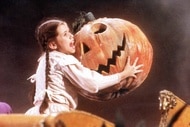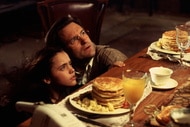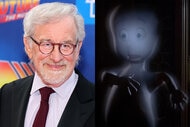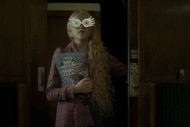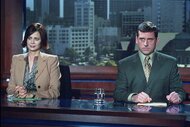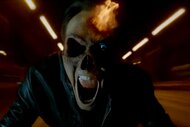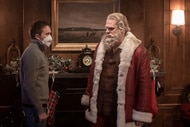'The Rings of Power' prosthetics head on orcs, Adar, and dwarf women beards
Jamie Wilson reveals some of the secrets of Prime Video's Lord of the Rings series.

Behind every pointy ear and scarred face in Middle-earth, there are some truly incredible prosthetics. Celebrimbor may be a master smith in Prime Video's The Lord of the Rings: The Rings of Power, but his powers are nothing compared to what the show's prosthetics department produces.
Jamie Wilson, the head of prosthetics for the new series, is no stranger to Middle-earth. He is a veteran of The Lord of the Rings movie trilogy (as well as Star Trek), and he knew that he and his team had to break new ground to bring the Second Age to life while also not straying too far from the path. Orcs are a little different in the Second Age, but they’re still easily identified. Some things change, while others will always remain the same; including the presence of Jed Brophy, who played multiple orcs in The Lord of the Rings and the dwarf Nori in all three movies of The Hobbit.
How did Wilson maintain the balance? Was the newly introduced Adar a challenge? What about dwarven women and beards? SYFY WIRE caught up with him to talk about all of this and more.
When we watch this show, we don’t really see the prosthetics, we just see the characters. It’s seamless. Was that the goal?
Well with our prosthetic design, we tried to retain as much of the active features as we could, and kept it light if we could, so that the actor can perform. The more you apply to the face, the less they can move with their normal features. So the whole way through, it's always been let the actors' face come through, to try and keep that. And when we were casting for the orcs and stuff like that, we very much tried to pick actors that were right for the look to then be added to.
With the elves, and stuff with their ears, we worked on the ear design... I mean, obviously, they're not their own ears, because most humans do not have tips on the top of their ears, but the design of it was to be in keeping with their face. It's amazing how much — with the ear design — how many of the lines line up with the actor's actual face. The top of the cheekbone, the bottom cheekbone, it all feels more natural, rather than something that's just been stuck on. So there was a lot of work that was done to integrate it and might make it feel light and in keeping with the actor to let them shine through.
How much influence did you take from the look of the prosthetics of some of these races that we've already seen in the six Peter Jackson movies?
At the end of the day, this is a whole different time, and it is a great new story… worlds that obviously have less writing about them. It opens up the showrunners to go wild with what they want to do. But at the same time, we have to remember it is a period before the period we all know. So therefore there needs to be some linkage for the fans to go, "Oh, those hobbits, oh my god, they're going to be the precursors to the hobbits,” so there has to be some link through.
If you go and radically change it, then there isn't a marriage of memories and thoughts about the fans across it. There are definitely some links. It is trying to create our own look for this production, but at the same time harking back to the memories of the older production. So yes there is some crossover. You know, [J.R.R.] Tolkien wrote about the hobbit feet. We can't suddenly have them with one toe and tiny feet. It would be a bit of an extreme difference.
The orcs on the show are familiar yet they're definitely of a different age. How did you manage that balance? They feel older but there's no question about what and who they are.
It's kind of funny. If you go back to when we did The Lord of the Rings, we were leading the genre. Since then, there's been a lot of other productions that have come out. So people kind of forget that actually, that look that was in Lord of the Rings is the look that we created for orcs. We could have gone a different way back in 1999. Who knows where we could have gone? So it's almost like it's our stamp on the world. That's why there has to be some familiarity.
This time obviously… we are before the world of past productions. So that means we looked at various things. Some simple things we looked at were, well, there are orcs from our world, fine, but they're not the big battling kind of orcs yet. They've had some skirmishes, but we haven't been through the whole big battle sequence where they're breeding Uruk-hai and orcs and they're all muscle-y, war machines. We've not got there yet.
We're more of a time when they've kind of come out of Middle-earth, they've been squashed back down underground, and they're spending a lot of time in hiding and caves and tunnels and hidden away. We played on the lighter skin tone, a bit like someone's in the dark all the time. They're hidden away… there’s that whole sunlight thing that we are now beginning to see as they come out and suffering with the bright sun. Just like anyone who's never been exposed to UV, coming out onto the surface and having to deal with their skin's reaction to that.
That's where a lot of it came through. So it was… you might say, baby-like. It’s the first birthing of the orcs coming out into the world of Middle-earth, to dominate again. And therefore, with that, comes their skin issues, their skin coloration, and thinner and more sinewy, and less bulky.
And still no Witchy-poo noses… and always Jed Brophy.
Yeah, well Jed... you can't do a production without Jed Brophy. Let's be honest. He is the official orc of The Lord of the Rings, in any form. He's also a great performer and willing to throw himself around for us, so god bless him.
We've seen dwarves before, but Prince Durin is something else. How did you go about achieving his look? The actor and the look just comes together in such a memorable character.
Well, that's a casting genius moment to start with, because I remember the first time I met [Owain Arthur] and he was coming across the studio lot, and he was laughing and giggling and jumping around. That basically was the starting point. Then obviously we're integrating the nose and ears, but it was a full-encompassing thing, because the beard is a major part of it, the hairstyle. I'm from the prosthetics department, and all the beard and hair work was done by the makeup department. It was a joint effort to bring him to life. It's a sizeable nose, but kept very much a nose. There's no facial prosthetic across the cheekbones or forehead. It lets his face express. I know there's quite a bit of beard and hair over that, but it actually has got an awful lot of movement as he's performing. And that was the important part.
We’d be remiss if we didn't ask about Princess Disa and whether there were any discussions about dwarf women and beards.
Yes, there was. It was a broader discussion. It was dwarf women, beards, dwarf women, facial hair; all those kind of things. How do you go there with this? They are burly, strong women in their own right… but at the same time, they are females. We didn't want to turn them into giant beards and lose that femininity. You'll actually see, on shots with Disa, there are more light, curly little hairs on her face. She's hairier, but not lost under a giant beard. We did want the feminine-ness to come through, cause it's a new thing with the whole female dwarves.
How many pairs of elf ears would you say your department goes through on a daily basis?
Oh, it depends upon the shooting, but it could be... I mean, on an extras day, you could be looking at maybe a hundred? The number is astronomical for what we've done across the entire season shoot.
Could they be worn again, or was it similar to how it was before, only good for one day?
Yes and no. There are two ways you can do ears. They’re all made with encapsulated silicone, but the normal ear is a one-time only. So it's applied, and then as it comes off you can't use it again. However, a little bit of movie trickery, depending upon the character… it doesn't work with elves because their haircut tends to be, in this production, quite back or shaved, around the ear… but when it came to the dwarves, for example, who have a lot of hair, you actually take an ear and you stick it with wig lace in a circle around the ear, and then you stick the lace to their head. Then they put the wig on you can't see the lace. And then when it comes to the end, you just gently unglue the lace, pop it off, and you can use it again. So it depends.
Most of the time we couldn't do that. You couldn't do it on leads, or anything like that, even if they had suitable hair. It was mainly with the extras and only in certain characters, or races, rather, we could do it.
Which character would you say has the most prosthetics done to them? Who's showing up the earliest to get their prosthetics?
Well obviously it's the orcs, I mean the hero orcs; they all have full facial prosthetics. That's a full head. As far as the lead characters and such, that would be Adar, because he has high cheekbone prosthetics, and he has ears… and then he has, it's not so much applied prosthetics, but he has scars and a whole paint scheme to give that septic, slightly eerie skin tone to him. And so he takes longer than the hero orcs, which have full facial prosthetics totally encompassing their face.
What character gave you your biggest challenge in terms of prosthetics?
It probably was Adar, only because it was very important to not reduce his performance. He's a lead role… very important not to reduce his performance facially, as far as his movement. But also, to get the balance between, what is he? He's not a beastie, or a creature; that whole kind of elf. It was many iterations. We went through cheekbones, different sizes, until we found the balance and what worked with his face, and what he was happy with.
So that was the biggest challenge and the hardest amount of work. An orc is in full prosthetics, it's way more work as such, but it didn't need so many iterations and changes and tweaks to get the balance just right. Whereas Adar, there are so many things in play to just get it just right for the look. So that was probably the hardest one as far as backward and forward.
The Lord of the Rings: The Rings of Power is streaming on Amazon Prime right now, with new episodes coming out every Friday. This interview was edited for length and clarity.









